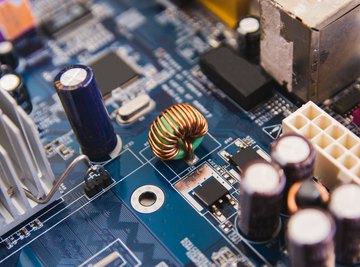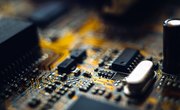
Since 1948, transistors have been used in electronics. Originally made with germanium, modern transistors use silicon for its higher heat tolerance. Transistors amplify and switch signals. They can be analog or digital. Two prevalent transistors today include Metal-Oxide-Semiconductor Field Effect Transistors (MOSFET) and Bipolar Junction Transistors (BJT). MOSFET offers a number of advantages over BJT.
TL;DR (Too Long; Didn't Read)
Transistors, used to amplify and switch signals, heralded the modern electronics era. Today, two predominate transistors used include Bipolar Junction Transistors or BJT and Metal-Oxide-Semiconductor Field Effect Transistors or MOSFET. MOSFET offers advantages over BJT in modern electronics and computers as these transistors are more compatible with silicon processing technology.
Overview of MOSFET and BJT
MOSFET and BJT represent the two main types of transistors used today. Transistors consist of three pins called an emitter, a collector and a base. The base controls the electric current, the collector handles the flow of the base current, and the emitter is where the current flows out. Both MOSFETs and BJTs are generally made from silicon, with a smaller percentage made from gallium arsenide. They can both work as transducers for electrochemical sensors.
Bipolar Junction Transistor (BJT)
A BJT (Bipolar Junction Transistor) combines two junction diodes from either a p-type semiconductor between to n-type semiconductors or a layer of n-type semiconductor between two p-type semiconductors. The BJT is a current-controlled device with a base circuit, essentially a current amplifier. In BJTs, the current travels through the transistor across holes or bonding vacancies with positive polarity and electrons with negative polarity. BJTs are used in many applications including analog and high power circuits. They were the first mass-produced type of transistor.
Metal-Oxide-Semiconductor Field Effect Transistors (MOSFET)
MOSFET is a type of Field Effect Transistor that is used in digital integrated circuits like microcomputers. The MOSFET is a voltage-controlled device. It has a gate terminal rather than a base, separated from other terminals by oxide film. This oxide layer serves as an insulator. Instead of an emitter and a collector, MOSFET has a source and a drain. MOSFET is notable for its high gate resistance. The gate voltage determines whether the MOSFET turns on or off. Switching time occurs between its on and off modes.
Advantages of MOSFET
Field Effect Transistors such as MOSFET have been used for decades. They comprise the most commonly used transistors, currently dominating the market for integrated circuits. They are portable, use low power, draw no current and are compatible with silicon processing technology. Their lack of gate current results in high input impedance. One additional major advantage of MOSFET over BJT is that it forms the basis of a circuit with switches of analog signals. These are useful in data acquisition systems and allow several data inputs. Their switching ability between different resistors aids in attenuation ratio, or changing the gain of operational amplifiers. MOSFETs form the basis of semiconductor memory devices such as microprocessors.
References
- New Jersey Institute of Technology Electrical and Computer Engineering Department Undergraduate Laboratory: Lab 10: The Transistor Comparison of Two Basic Types: MOS and Bipolar
- ROHM Semiconductor: History of Transistors
- ROHM Semiconductor: Outline of a Transistor
- ROHM Semiconductor: Understanding MOSFET Characteristics
About the Author
J. Dianne Dotson is a science writer with a degree in zoology/ecology and evolutionary biology. She spent nine years working in laboratory and clinical research. A lifelong writer, Dianne is also a content manager and science fiction and fantasy novelist. Dianne features science as well as writing topics on her website, jdiannedotson.com.
